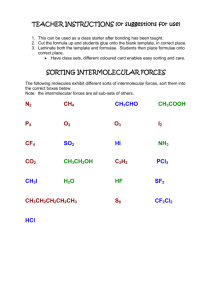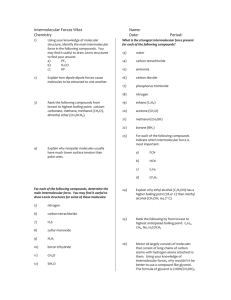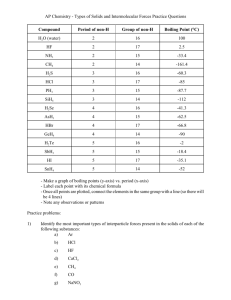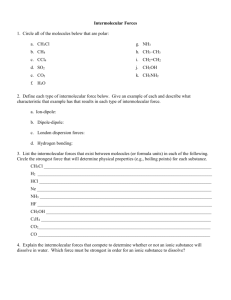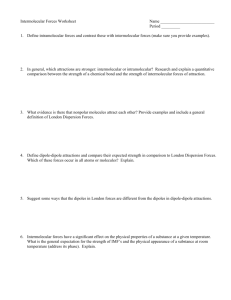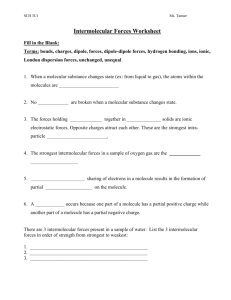Intermolecular Forces and Adhesives
advertisement
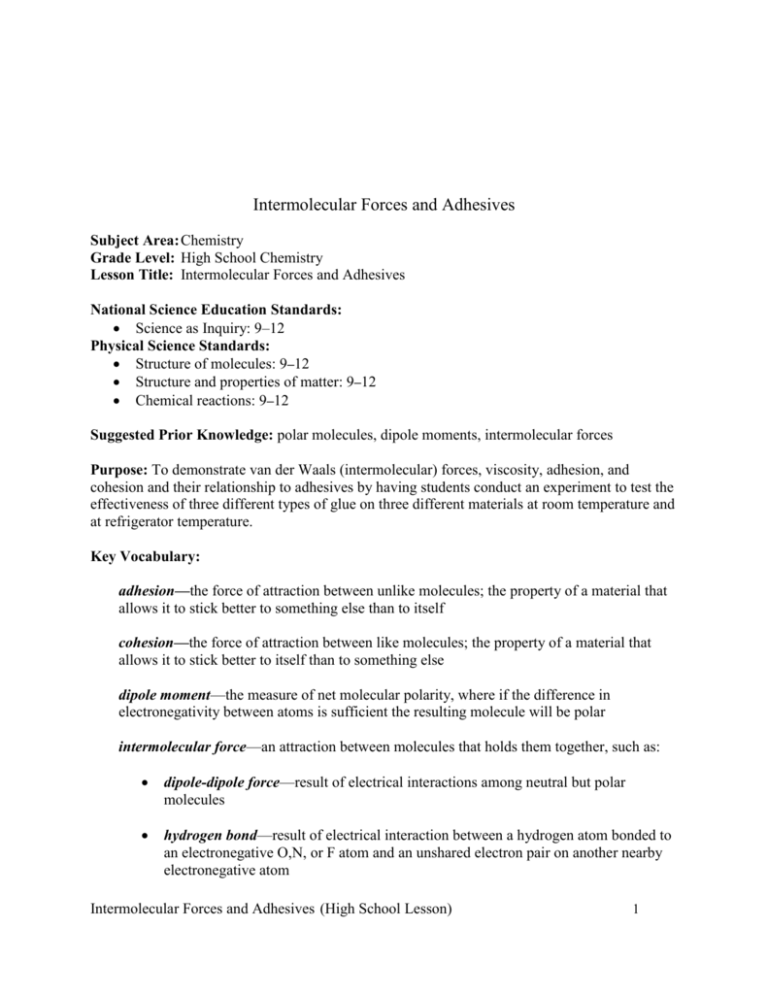
Intermolecular Forces and Adhesives Subject Area: Chemistry Grade Level: High School Chemistry Lesson Title: Intermolecular Forces and Adhesives National Science Education Standards: Science as Inquiry: 9–12 Physical Science Standards: Structure of molecules: 9–12 Structure and properties of matter: 9–12 Chemical reactions: 9–12 Suggested Prior Knowledge: polar molecules, dipole moments, intermolecular forces Purpose: To demonstrate van der Waals (intermolecular) forces, viscosity, adhesion, and cohesion and their relationship to adhesives by having students conduct an experiment to test the effectiveness of three different types of glue on three different materials at room temperature and at refrigerator temperature. Key Vocabulary: adhesion—the force of attraction between unlike molecules; the property of a material that allows it to stick better to something else than to itself cohesion—the force of attraction between like molecules; the property of a material that allows it to stick better to itself than to something else dipole moment—the measure of net molecular polarity, where if the difference in electronegativity between atoms is sufficient the resulting molecule will be polar intermolecular force—an attraction between molecules that holds them together, such as: dipole-dipole force—result of electrical interactions among neutral but polar molecules hydrogen bond—result of electrical interaction between a hydrogen atom bonded to an electronegative O,N, or F atom and an unshared electron pair on another nearby electronegative atom Intermolecular Forces and Adhesives (High School Lesson) 1 ion-dipole force—result of electrical interactions between an ion and the partial charges of a polar molecule London dispersion force—result of instantaneous and temporary electrical interaction among molecules that are electrically neutral and that have a zero dipole moment van der Waals forces—an alternative name for intermolecular forces, in honor of Dutch scientist Johannes van der Waals viscosity—the measure of a liquid’s resistance to flow. It is also a term for the ease with which molecules flow in relation to intermolecular forces. Objectives: 1. Students will experience intermolecular forces through experimentation 2. Students will be able to describe how adhesives relate to intermolecular forces Materials (each group should receive the following): - student worksheet - 4 oz bottle of white glue - small bottle of rubber cement - 4 oz bottle of wood glue - (12) 4.25″ × 5.5″ rectangles of acetate (transparency sheets). Cut one 8.5” x 11”sheet into four pieces - (12) 4.25″ × 5.5″ rectangles of cardboard - (12) 4.25″ × 5.5″ rectangles of heavy duty aluminum foil - access to a refrigerator - goggles and lab safety equipment as needed - permanent marker Procedure: 1. Discuss intermolecular forces and their varying relationships to liquids and solids with students by asking them the following questions: Can you give an example of a liquid and identify the intermolecular forces involved (e.g., H2O and hydrogen bonding)? What is the connection between intermolecular forces and solids? What effect can temperature have on intermolecular forces? How do you think glues work? What characteristics do glues share with liquids and solids? What effect will temperature have on adhesives such as glue? 2. Divide the class into groups of four and provide the materials for each group. The acetate, cardboard, and aluminum will represent surface materials. Each adhesive will be tested in its ability to bond with each surface material at room temperature and at refrigerator temperature. 3. Facilitate a discussion on experimental procedure. Some of the following questions can help: Intermolecular Forces and Adhesives (High School Lesson) 2 How can we test the intermolecular forces of each adhesive? Who can provide a hypothesis for this experiment? What variables do we need to account for? What data should we collect? 4. Begin the experiment by having the students record the room temperature and refrigerator temperature. 5. Paint a consistent sized circle of each adhesive between two pieces of each material, gluing them together. Make two sets, one that will go into the refrigerator and one that will stay at room temperature. 6. Mark each sample with a relevant sample identification (use the Sample Identification Key on the student worksheet as a reference). Set nine test samples aside to cure at room temperature and put the other nine samples in the refrigerator. 7. Record the time at which all of the samples have begun to cure. 8. After approximately 24 hrs (suggested time interval) remove all of the samples from their curing locations. 9. Have the group appoint a person as the official “force applier.” Taking the refrigerated samples first, have that person try to separate each sample by gradually applying a pulling force to the materials. By observing their “force applier,” the group should rate the ability of the intermolecular forces to hold the material together using a scale in which 1 is the weakest and 5 is the strongest. 10. Have each group discuss their findings and create their conclusion. Additional Resources: http://www.chemistryexplained.com/A-Ar/Adhesives.html http://www.chem.ufl.edu/~itl/2045/lectures/lec_g.html http://www.explainthatstuff.com/adhesives.html Intermolecular Forces and Adhesives (High School Lesson) 3 Student Worksheet for Intermolecular Forces and Adhesives Experiment Title: ________________________________ Date: ________ Name: _______ Student Hypothesis: ___________________________________________________________________________ Materials: ___________________________________________________________________________ Procedure: ____________________________________________________________________________ ____________________________________________________________________________ ____________________________________________________________________________ _____________________________________________________________________________ _____________________________________________________________________________ ______________________________________________________________________________ Intermolecular Forces and Adhesives (High School Lesson) 4 Data: Refrigerator ________°C Room ________°C Timei Timef Total Time Sample Identification Key White Glue Rubber Cement Wood Glue Acetate White ____°C Acetate Rubber ____°C Acetate Wood ____°C Acetate Acetate White ____°C Acetate Rubber ____°C Acetate Wood ____°C Acetate Cardboard White ____°C Cardboard Rubber ____°C Cardboard Wood ____°C Cardboard Cardboard White ____°C Cardboard Rubber ____°C Cardboard Wood ____°C Cardboard Aluminum White ____°C Aluminum Rubber ____°C Aluminum Wood ____°C Aluminum Aluminum White ____°C Aluminum Rubber ____°C Aluminum Wood ____°C Aluminum Intermolecular Forces and Adhesives (High School Lesson) 5 Intermolecular Forces and Adhesives (High School Lesson) 6 Acetate ________° C Acetate ________° C Cardboard ________° C Cardboard ________° C Aluminum ________° C Aluminum ________° C White Glue Rubber Cement Observations Wood Glue Describe the effect of temperature on the cohesive forces for each adhesive: White Glue: ______________________________________________________________________________ ______________________________________________________________________________ ______________________________________________________________________________ Rubber Cement: ______________________________________________________________________________ ______________________________________________________________________________ ______________________________________________________________________________ Wood Glue: ______________________________________________________________________________ ______________________________________________________________________________ ______________________________________________________________________________ Describe the effect of temperature on the adhesive forces for each adhesive: White Glue: ______________________________________________________________________________ ______________________________________________________________________________ ______________________________________________________________________________ Rubber Cement: ______________________________________________________________________________ Intermolecular Forces and Adhesives (High School Lesson) 7 ______________________________________________________________________________ ______________________________________________________________________________ Wood Glue: ______________________________________________________________________________ ______________________________________________________________________________ ______________________________________________________________________________ Conclusion (use the back if necessary): ______________________________________________________________________________ ______________________________________________________________________________ Intermolecular Forces and Adhesives (High School Lesson) 8

